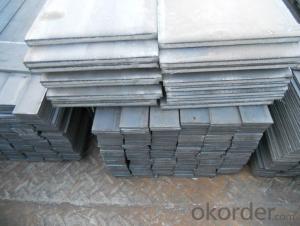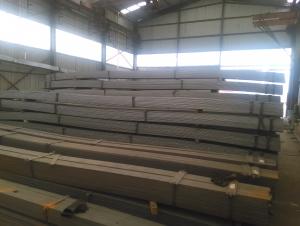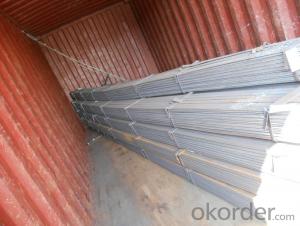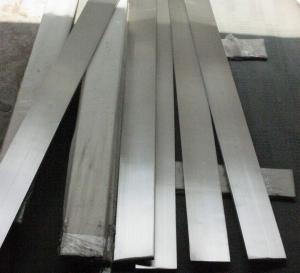Steel flat bars; flat steel high quality
- Loading Port:
- Shanghai
- Payment Terms:
- TT OR LC
- Min Order Qty:
- 25 m.t.
- Supply Capability:
- 10000 m.t./month
OKorder Service Pledge
OKorder Financial Service
You Might Also Like
Production Flow of STEEL FLAT SS400
The steel flat bar is made through three processes:
1.Feeding the material: Feeding the row material (the steel plate) to Slitting Line.
2.Slitting:The steel plate would be slitted into expected width by lengthways cutter.
3. Leveled and cutting: The plat bar would be ground into level by the grinder and then cut into required length
Tangshan flat bar processing plant
Our factory was founded in 2008, has been formed steel processing, trade, distribution, haihe river transportation and information service in the integration of modern company, the headquarters is located in the national steel rich district of tangshan city, hebei province, the first big province, covers an area of 20 mu, is apart from the beijing-shenyang high-speed 0.5 kilometers tangshan north exit, the geographical position is superior, the traffic is convenient.
The company owns the most advanced domestic shear steel equipment, plasma cutting equipment, can according to customer demand for steel plate kaiping, slitting, crosscutting, shear and winding and other personalized processing services, enable customers to save steel cut expenses and losses, greatly reduce the production cost, improve production efficiency. Its main products are steel billet, steel strip, flange plate and web plate, flat steel, open the tablet, etc.
Products applied to the export of flat steel, steel structure, steel plate, cars, ships, cement, steel girder plate socket, machinery manufacturing, bridge template, and other industries. Processing width: 10 mm - 1250 mm, the thickness of 1.5 mm - 16 mm, the length can be due to the needs of customers, annual processing capacity of 100000 tons. Product quality in line with the GB/T 709-2006carbon structure and hot rolled steel plate and strip of low alloy structure" of the relevant requirements.
In the increasingly market competition, the company in good faith integrity, mutual benefit and win-win principle sincerely look forward to cooperating with you!
Product description:
Processing capacity: 100000 tons/year; Slitting precision (width) : 0.5 mm or less
Raw material: Q235B, Q345B, Q235-1 b crosscutting precision (length) : 2 mm or less
Processing: the thickness of 2.0-16 mm; Shear length: 2000 mm above
Wide degree: 15-1250 - mm; Leveling precision: 1-2 MMM squared
- Q:Can steel flat bars be used in the manufacturing of furniture?
- Yes, steel flat bars can be used in the manufacturing of furniture. Steel flat bars are strong and durable, making them suitable for creating sturdy furniture pieces. They can be used as support structures, frames, or as decorative accents in various types of furniture like tables, chairs, shelves, and cabinets. Steel flat bars can be easily shaped and welded to create customized furniture designs. Additionally, steel flat bars can be finished in different coatings, such as powder coating or galvanization, to enhance their appearance and protect against rusting. Overall, steel flat bars offer versatility and strength, making them a popular choice for furniture manufacturing.
- Q:What is the use of slitting flat steel?
- Flat cut flat steel, also called fine shearing flat steel strip, can be used to produce iron, tools and mechanical parts, and is used as frame structures and escalators for buildings.
- Q:Can steel flat bars be painted or powder-coated?
- Yes, steel flat bars can be painted or powder-coated. Painting or powder-coating steel flat bars can provide protection against corrosion, enhance their appearance, and allow for customization. Prior to painting or powder-coating, the surface of the steel flat bars should be properly prepared by removing any rust, dirt, or oil. This can be done through cleaning, sanding, or using a primer. Once the surface is prepared, a suitable paint or powder coating can be applied. This process will ensure that the steel flat bars are protected and have a durable and aesthetically pleasing finish.
- Q:How do you determine the fracture toughness of a steel flat bar?
- There are various methods available to determine the fracture toughness of a steel flat bar. However, the most common and reliable technique is the ASTM E399 standard test method, also known as the "Standard Test Method for Plane-Strain Fracture Toughness of Metallic Materials." To conduct the ASTM E399 test method, a test called the "Charpy V-notch test" or the "standard test specimen" test is performed. This involves subjecting a rectangular specimen with a V-shaped notch to impact using a swinging pendulum. The specimen is clamped at both ends, and the pendulum strikes the center, causing it to fracture. During this fracture, the energy absorbed by the specimen is recorded and used to calculate the fracture toughness. This calculation takes into account the dimensions of the specimen, the energy absorbed, and the geometry of the V-notch. It's important to note that the ASTM E399 test method is specifically designed for determining plane-strain fracture toughness. This refers to the fracture toughness under conditions where the deformation is primarily two-dimensional, and the stress is evenly distributed across the thickness of the specimen. This is usually the case for flat bars with a width much larger than the thickness. By following the ASTM E399 standard test method, manufacturers, researchers, and engineers can accurately determine the fracture toughness of a steel flat bar. This information is crucial for evaluating the material's ability to resist crack initiation and propagation. It plays a vital role in the design of safe and reliable structures and components.
- Q:Can steel flat bars be used for manufacturing tools?
- Indeed, the utilization of steel flat bars in the production of tools is possible. Due to their exceptional strength, durability, and adaptability, steel flat bars are widely employed in the manufacturing of tools. They can be effortlessly molded and machined into diverse tool configurations, rendering them appropriate for an extensive array of applications. Moreover, steel flat bars are renowned for their ability to resist wear and damage, making them the perfect choice for tools that endure frequent usage and interaction with tough materials. Furthermore, by subjecting steel flat bars to heat treatment, their mechanical characteristics, such as hardness and toughness, can be further enhanced, thus augmenting their suitability for tool fabrication.
- Q:Are steel flat bars suitable for making agricultural implements?
- Yes, steel flat bars are suitable for making agricultural implements. Steel flat bars offer high strength, durability, and resistance to wear and tear, making them ideal for withstanding the demanding conditions and heavy use associated with agricultural tasks. Additionally, their versatility allows for easy customization and shaping to meet specific requirements of different implements.
- Q:What are the different types of surface finishes for brass steel flat bars?
- There are several different types of surface finishes available for brass steel flat bars, each offering unique properties and aesthetics. Some of the most common surface finishes for brass steel flat bars include: 1. Mill Finish: This is the most basic and natural surface finish, typically achieved through the initial manufacturing process. It has a rough and uneven appearance, with visible tool marks and imperfections. Mill finish is often chosen for its cost-effectiveness and suitability for applications that do not require a smooth or polished surface. 2. Brushed Finish: This finish is achieved by brushing the surface of the brass steel flat bar with abrasive materials, typically in a linear pattern. It results in a smooth and uniform texture with visible brush marks. Brushed finish is often preferred for applications that require a decorative and contemporary appearance. 3. Polished Finish: Polished finish involves enhancing the surface of the brass steel flat bar to achieve a high level of shine and reflectivity. It is achieved through a series of polishing and buffing processes, using progressively finer abrasive materials. Polished finish is commonly used in decorative applications, as it creates a luxurious and elegant appearance. 4. Satin Finish: Satin finish is similar to brushed finish but with a softer and more refined texture. It is achieved by using fine abrasive materials to create a smooth and consistent non-reflective surface. Satin finish is often chosen for its matte appearance and its ability to hide scratches and fingerprints, making it suitable for highly visible applications such as architectural elements and furniture. 5. Antique Finish: Antique finish involves treating the surface of the brass steel flat bar to create an aged or weathered appearance. This can be achieved through various methods such as chemical treatments, oxidation, or distressing techniques. Antique finish is commonly used in furniture and decorative items to add a vintage or rustic look. 6. Powder Coating: Powder coating is a process where a dry powder is electrostatically applied to the surface of the brass steel flat bar and then cured to form a durable and protective layer. It offers a wide range of color options and provides excellent resistance to corrosion, chemicals, and UV rays. Powder coating is often chosen for its versatility and durability in outdoor applications. These are just a few examples of the different types of surface finishes available for brass steel flat bars. The choice of finish depends on the desired aesthetic, functionality, and the specific requirements of the application.
- Q:Are steel flat bars suitable for agricultural applications?
- Indeed, agricultural applications can certainly benefit from the use of steel flat bars. Steel, being an incredibly resilient and robust material, can easily endure the strenuous demands imposed by agricultural activities. These flat bars find utility in a wide array of agricultural applications, including the construction of equipment and machinery, the erection of structures and fences, and even for general repairs and maintenance tasks. With their exceptional strength and stability, steel flat bars exhibit the capability to withstand heavy loads and the harshest weather conditions. Moreover, their versatility allows for easy shaping and welding, thus permitting customization to meet specific requirements. Ultimately, when it comes to agricultural applications, steel flat bars present themselves as a dependable and enduring choice.
- Q:What are the different grades of steel flat bars?
- The different grades of steel flat bars typically include low carbon, mild steel, high carbon, and alloy steel grades.
- Q:Are steel flat bars galvanized?
- No, steel flat bars are not typically galvanized. Galvanization is a process that involves coating steel with a layer of zinc to protect it from corrosion. While galvanization is commonly used for steel products, such as pipes or sheets, steel flat bars are usually left ungalvanized as they are primarily used for structural purposes rather than for protection against rust.
1. Manufacturer Overview |
|
|---|---|
| Location | |
| Year Established | |
| Annual Output Value | |
| Main Markets | |
| Company Certifications | |
2. Manufacturer Certificates |
|
|---|---|
| a) Certification Name | |
| Range | |
| Reference | |
| Validity Period | |
3. Manufacturer Capability |
|
|---|---|
| a)Trade Capacity | |
| Nearest Port | |
| Export Percentage | |
| No.of Employees in Trade Department | |
| Language Spoken: | |
| b)Factory Information | |
| Factory Size: | |
| No. of Production Lines | |
| Contract Manufacturing | |
| Product Price Range | |
Send your message to us
Steel flat bars; flat steel high quality
- Loading Port:
- Shanghai
- Payment Terms:
- TT OR LC
- Min Order Qty:
- 25 m.t.
- Supply Capability:
- 10000 m.t./month
OKorder Service Pledge
OKorder Financial Service
Similar products
New products
Hot products
Related keywords




























